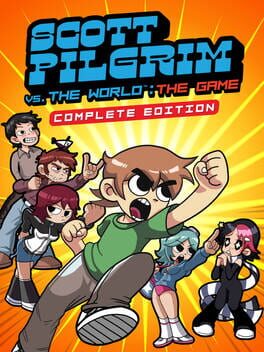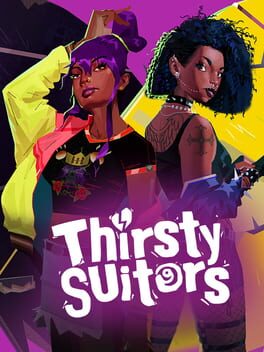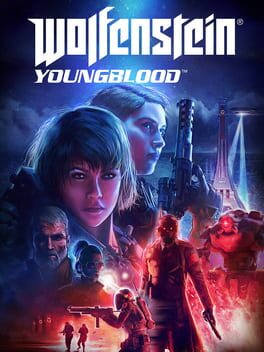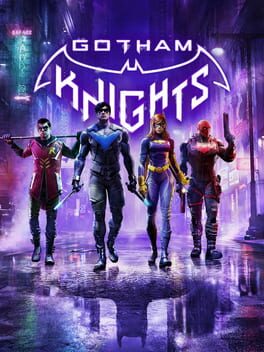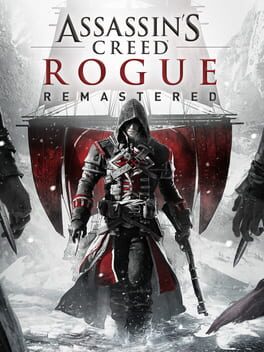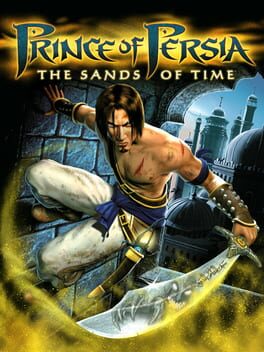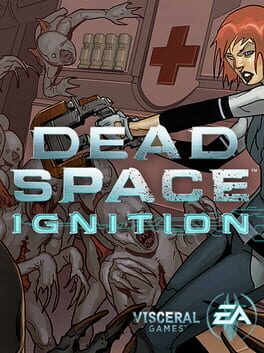Jaxvor
11 reviews liked by Jaxvor
Halo Infinite
2021
Co-op online was a mixed bag. While I had fun messing about in the open world with a friend, as well as coming up with different tactics to defeat the tougher bosses, the linear levels didn't feel like they were designed with co-op in mind. Firing your weapon and the hit being registered by an enemy had a noticeable delay. The most frequent bug was the game not registering the equipment that I wanted to switch to, which always seemed to happen in the middle of a firefight. The only resolution was to ask my friend to kill me to death, which he happily obliged. Thanks, Aaron.
Scott Pilgrim vs. The World is a game that's carried by its looks and nothing else.
While the gameplay is enjoyable in the early levels, especially in co-op, the difficulty really ramps up fast. The game got so difficult that my co-op partner and I eventually abandoned our playthrough because we weren't having a good time anymore.
The game is pretty buggy too, some of which that led to the game crashing to the PS5 home screen, resulting in my co-op partner losing progress they had made with their character on more than one occasion.
My overall feelings towards the game are pretty negative. If you're looking for a brawler-style video game to play with friends, I would pick Castle Crashers Remastered over this any day.
While the gameplay is enjoyable in the early levels, especially in co-op, the difficulty really ramps up fast. The game got so difficult that my co-op partner and I eventually abandoned our playthrough because we weren't having a good time anymore.
The game is pretty buggy too, some of which that led to the game crashing to the PS5 home screen, resulting in my co-op partner losing progress they had made with their character on more than one occasion.
My overall feelings towards the game are pretty negative. If you're looking for a brawler-style video game to play with friends, I would pick Castle Crashers Remastered over this any day.
Thirsty Suitors
2023
Oddly charming, interesting and super creative, Thirsty Suitors throws a lot of ideas at the wall. Part skateboarding, part turn based RPG, part rhythm based game, part cooking game, Thirsty Suitors does a lot with its relatively short experience and I'm not sure it was worth it.
All these ideas don't really mix well. While none are outright bad, I don't think I can say I enjoyed any that much. The combat/RPG mechanics are probably the closest to being really good.
Thirsty Suitors' silly energy and creativity shines in this area which is the game's biggest pro, mostly because of all the weird special attacks the game gives you.
Fighting overall is fairly straightforward. You've got a health bar, a MP/WP bar as well, you can do normal attacks, special attacks that consume WP/MP, and items to help boost your stats, your health, etc. Normal attacks will help fill up your WP bar slowly so there is some strategy to the attacks you do.
The fighting also features a taunt ability that is key to combat. Most enemies feature a weakness that you can exploit for bigger damage. Figuring out what their weakness is can be done through taunting. You can flirt with someone and get them thirsty for you to the point they can't attack you properly, you can shock them by saying something so brash and out of left field that they aren't able to attack you for a few turns, etc. etc.
Using these taunts and finding the weaknesses of your enemies will open them up to your special attacks as well. The taunt's ability will last for a few turns so you'll be able to do bigger special attacks that correspond to these types of taunts for bigger damage.
The combat itself is pretty by the book and over time, the crazy attacks and rhythm based button timing sections get old really fast since all special attacks require you to do these button timing sections.
When you're not in battle, you're skating around the two sections of this game. The skating sections are maybe the worst part of the game sadly. Skateboarding is forced upon you in certain sections of the game. This is aggravating because you just don't go fast on the skateboard. It's just way too slow. There are a few areas where you can walk instead. This is equally annoying because you can actually run and seemingly go faster on foot.
On top of that, the game is very kind with how easy you attach to grinding/trick sections, so its difficult to take shortcuts without getting stuck doing a line and getting stuck going in a direction you don't want to actually go towards, taking more time to get back on the right path and making the shortcut feel like a longer route.
You can kinda do tricks but the trick system is incredibly limited, making that section get real old pretty quickly.
There's also a cooking section that helps you make items that you can use in battle. This section isn't too bad but it's just a different rhythm based input section similar to what you get in battles with your skill based attacks.
Outside of this and a few technical issues I ran into, the game isn't all bad. The story is a bit messy, but overall a nice story. The story along with the wild creativity surrounding the ex battles and other over-the-top characters was fun enough to stick through some of the gameplay flaws. Results may vary in this but overall, Thirsty Suitors is worth giving a try if any of the trailers/clips/pictures have piqued your interest. You might not stick with it to completion, but the overall charm, story and creativity is worth a trial run at the very least. Especially since it's currently on Game Pass (as of this writing).
All these ideas don't really mix well. While none are outright bad, I don't think I can say I enjoyed any that much. The combat/RPG mechanics are probably the closest to being really good.
Thirsty Suitors' silly energy and creativity shines in this area which is the game's biggest pro, mostly because of all the weird special attacks the game gives you.
Fighting overall is fairly straightforward. You've got a health bar, a MP/WP bar as well, you can do normal attacks, special attacks that consume WP/MP, and items to help boost your stats, your health, etc. Normal attacks will help fill up your WP bar slowly so there is some strategy to the attacks you do.
The fighting also features a taunt ability that is key to combat. Most enemies feature a weakness that you can exploit for bigger damage. Figuring out what their weakness is can be done through taunting. You can flirt with someone and get them thirsty for you to the point they can't attack you properly, you can shock them by saying something so brash and out of left field that they aren't able to attack you for a few turns, etc. etc.
Using these taunts and finding the weaknesses of your enemies will open them up to your special attacks as well. The taunt's ability will last for a few turns so you'll be able to do bigger special attacks that correspond to these types of taunts for bigger damage.
The combat itself is pretty by the book and over time, the crazy attacks and rhythm based button timing sections get old really fast since all special attacks require you to do these button timing sections.
When you're not in battle, you're skating around the two sections of this game. The skating sections are maybe the worst part of the game sadly. Skateboarding is forced upon you in certain sections of the game. This is aggravating because you just don't go fast on the skateboard. It's just way too slow. There are a few areas where you can walk instead. This is equally annoying because you can actually run and seemingly go faster on foot.
On top of that, the game is very kind with how easy you attach to grinding/trick sections, so its difficult to take shortcuts without getting stuck doing a line and getting stuck going in a direction you don't want to actually go towards, taking more time to get back on the right path and making the shortcut feel like a longer route.
You can kinda do tricks but the trick system is incredibly limited, making that section get real old pretty quickly.
There's also a cooking section that helps you make items that you can use in battle. This section isn't too bad but it's just a different rhythm based input section similar to what you get in battles with your skill based attacks.
Outside of this and a few technical issues I ran into, the game isn't all bad. The story is a bit messy, but overall a nice story. The story along with the wild creativity surrounding the ex battles and other over-the-top characters was fun enough to stick through some of the gameplay flaws. Results may vary in this but overall, Thirsty Suitors is worth giving a try if any of the trailers/clips/pictures have piqued your interest. You might not stick with it to completion, but the overall charm, story and creativity is worth a trial run at the very least. Especially since it's currently on Game Pass (as of this writing).
Besides some ill-fitting RPG elements (for real, the damage-type mechanic made me tear my hair out), Youngblood is ultimately a entertaining small-scale addition to the Wolfenstein canon. That's partly due to the dorky-ass protagonists Soph and Jess, who prove a breath of fresh air from the gruff BJ of previous games. But the FPS also benefits from an enhanced sense of non-linear traversal, likely thanks to Dishonored dev Arkane's contributions. In all, I had a totally tubular time.
Gotham Knights
2022
Cyberpunk 2077
2020
Never have I played a game that has given me so many mixed feelings during my playthrough.
My playthrough was on patch 1.6 version of the game on a PlayStation 5.
===The stuff I liked===
I thought the setting of Night City is an interesting one. I think it’s the one distinguishing thing that makes Cyberpunk 2077 standout from other contemporary open world games. A lot of care and attention is on show with how detailed Night City is, even if the quality is not consistent across the board.
Voice acting is another highlight for the game. I very much enjoyed Cherami Leigh’s performance as female V, as well as enjoying the work of many of the supporting cast.
The side gig activities do a good job of having them take place in unique environments, so while you’re doing the same three or four objectives, I always felt that each area had me think of different ways to complete them.
===The stuff I disliked===
Going for a stealth build feels largely inconsequential to the story at large. If you want to challenge yourself by ghosting your way through missions, you’ll only end up taking much longer to play through the game. The game doesn’t react to how you complete missions, unless an optional objective specifically tells you to ghost through a level. It feels that the quest design was largely done with gunfights in mind.
The upgrade tree is expansive but uninspiring. I found myself having a hard time on what to spend my upgrade perks on. Most upgrades that are offered to you are small percentage increments, usually something like “increase critical damage by 5% for pistols”. None of the upgrades really change the way you play the game; the way you play the game at the start will largely play the same as it will do at the end. I really wished the upgrade perks was done away with and the cybernetic body parts dictated your play style, based on how the player spend their body attribute points.
Bugs. Despite being on the latest version of the game, at the time of writing, I experienced a surprisingly high number of bugs over my ~75 hour playthrough. Nothing that halted my progress to finish the game but it’s clear that this game is still riddled with problems, at least on the PS5.
Some notable bugs I had
- Random items floating in the air
- Low quality textures/shallow draw distances
- V’s voice changing from female to male when talking between two different characters (had to load a previous save to fix)
- Objects in the hands of NPCs being a couple of feet away from their hands, but moving about in the air as if they’re in their hands
- Missing voice clips/sound effects
- Enemies going into an alert phase for no reason.
The driving in the game is not very good. There is a plethora of vehicles you have access to but I found myself sticking to Jackie’s bike most of the time because it was the only vehicle that had decent handling.
The presentation. I grew tired with being made to sit down and have characters talk at me. Sitting and talking was what I remember mostly doing in the main quest. It wouldn’t be so much of an issue for me if they weren’t all presented from V’s perspective. I want to see my V physically react and emote during these dialogue moments, like you see with Geralt in The Witcher 3. Instead, I found myself getting bored and browsing on my phone than paying attention to the dialogue moments. It seems that CDPR prioritised the main quest to deliver plot via dialogue than having the plot meld nicely with the gameplay.
Overall, the game is…fine for the most part. If it wasn’t for setting of Night City, I believe the game would have completely forgettable. The game was enjoyable enough to have me stick with it for 75 hours. However, everything the game has to offer, in terms of its gameplay mechanics, other games have done them far better. There’s a good foundation for me to be interested in a sequel.
My playthrough was on patch 1.6 version of the game on a PlayStation 5.
===The stuff I liked===
I thought the setting of Night City is an interesting one. I think it’s the one distinguishing thing that makes Cyberpunk 2077 standout from other contemporary open world games. A lot of care and attention is on show with how detailed Night City is, even if the quality is not consistent across the board.
Voice acting is another highlight for the game. I very much enjoyed Cherami Leigh’s performance as female V, as well as enjoying the work of many of the supporting cast.
The side gig activities do a good job of having them take place in unique environments, so while you’re doing the same three or four objectives, I always felt that each area had me think of different ways to complete them.
===The stuff I disliked===
Going for a stealth build feels largely inconsequential to the story at large. If you want to challenge yourself by ghosting your way through missions, you’ll only end up taking much longer to play through the game. The game doesn’t react to how you complete missions, unless an optional objective specifically tells you to ghost through a level. It feels that the quest design was largely done with gunfights in mind.
The upgrade tree is expansive but uninspiring. I found myself having a hard time on what to spend my upgrade perks on. Most upgrades that are offered to you are small percentage increments, usually something like “increase critical damage by 5% for pistols”. None of the upgrades really change the way you play the game; the way you play the game at the start will largely play the same as it will do at the end. I really wished the upgrade perks was done away with and the cybernetic body parts dictated your play style, based on how the player spend their body attribute points.
Bugs. Despite being on the latest version of the game, at the time of writing, I experienced a surprisingly high number of bugs over my ~75 hour playthrough. Nothing that halted my progress to finish the game but it’s clear that this game is still riddled with problems, at least on the PS5.
Some notable bugs I had
- Random items floating in the air
- Low quality textures/shallow draw distances
- V’s voice changing from female to male when talking between two different characters (had to load a previous save to fix)
- Objects in the hands of NPCs being a couple of feet away from their hands, but moving about in the air as if they’re in their hands
- Missing voice clips/sound effects
- Enemies going into an alert phase for no reason.
The driving in the game is not very good. There is a plethora of vehicles you have access to but I found myself sticking to Jackie’s bike most of the time because it was the only vehicle that had decent handling.
The presentation. I grew tired with being made to sit down and have characters talk at me. Sitting and talking was what I remember mostly doing in the main quest. It wouldn’t be so much of an issue for me if they weren’t all presented from V’s perspective. I want to see my V physically react and emote during these dialogue moments, like you see with Geralt in The Witcher 3. Instead, I found myself getting bored and browsing on my phone than paying attention to the dialogue moments. It seems that CDPR prioritised the main quest to deliver plot via dialogue than having the plot meld nicely with the gameplay.
Overall, the game is…fine for the most part. If it wasn’t for setting of Night City, I believe the game would have completely forgettable. The game was enjoyable enough to have me stick with it for 75 hours. However, everything the game has to offer, in terms of its gameplay mechanics, other games have done them far better. There’s a good foundation for me to be interested in a sequel.
Being a game released in 2003, I had a lot of fun working out the platforming puzzles without modern design that obviously highlights what and where you should climb. The hint system does enough to prod you in the right direction without the game outright holding your hand. The dagger of time alleviates some of the fatal mistakes by allowing you to rewind time and have another ago, assuming you have enough sand to do so.
However, the combat was the single biggest point of frustration for me. While the combat is serviceable when dealing with a handful of enemies, there are five or six instances where the game will force you into combat challenges where you need to deal with wave after wave of enemies. As these combat challenges usually happen in small rooms, the enemies will easily gang up on you, knock you down, letting the other enemies continuously deal damage, before you have the chance to get up and block/dodge their attacks.
It's because of these moments that I will never pick this game up ever again.
However, the combat was the single biggest point of frustration for me. While the combat is serviceable when dealing with a handful of enemies, there are five or six instances where the game will force you into combat challenges where you need to deal with wave after wave of enemies. As these combat challenges usually happen in small rooms, the enemies will easily gang up on you, knock you down, letting the other enemies continuously deal damage, before you have the chance to get up and block/dodge their attacks.
It's because of these moments that I will never pick this game up ever again.
Pentiment
2022
Pentiment’s existence is an astounding one. This is not because it’s a game developed by Obsidian, as they have been celebrated for nearly twenty years as one of the premiere WRPG devs, nor it is because it’s the passion project of Josh Sawyer, who was one of the lead devs for Fallout: New Vegas and Pillars of Eternity 2, which are among Obsidian’s best games. This game is astounding in that such a clear labor of love that goes so hard against the grain of the mainstream game industry would have not existed if not for the support of the largest AAA publisher, Microsoft.
Pentiment isn’t a traditional RPG, even more so than fellow detective RPG Disco Elysium, as it’s more of an adventure game as it has no stats. I would still consider it a RPG though as the background and skills you choose for the protagonist, Andreas Maler, shapes what he can do and his relationships with the characters around him and the choices you make. Pentiment is also not a traditional detective game either for reasons that are bit spoilery, but one of them is that Andreas is not actually a detective. Andreas is not Sherlock Holmes, Harry DuBois, or Lady Love Dies; he is merely an artist completely out of his depth dragged into the rural Bavarian town of Tassing’s turmoil and forced to try and maintain the peace between the town and Kiersau, the Benedictine abbey who governs them. Andreas can’t Columbo his way to the truth, his and your choices are tinged with uncertainty as you try to uncover the culprits. Ultimately, the murders are a backdrop to the main theme of the game, history.
Pentiment is foremost a game about history, a rumination of the past and how society is built on the foundations of older ones, how they evolve and change over time, and how the past and its truths can be obfuscated through multiple means. The game take place in the Holy Roman Empire in the early 1500’s at the dawn of the great societal upheavals of the Early Modern period in Europe. Martin Luther has published his 95 Theses only a few years prior to the start of the game’s narrative, which will eventually lead to the greatest schism in Christianity, The Protestant Reformation, and more than a century of bloodshed and strife across the continent. Johannes Gutenberg’s printing press has revolutionized society as now the proliferation of books and the ability to read them are no longer only in the realm of the aristocracy and clergy. The growing education of the peasantry leads to class conflicts with their noble and clerical lords who desire to keep the underclasses under heel. The old traditions of the medieval era are dying away, this is initially illustrated with Keirsau and its monks, who are the very few still writing and illustrating books by hand. All of these events tie into the events of the game’s narrative and its setting and characters, and what a fantastic job the game does bringing them to life.
Pentiment’s attention to detail both to its historical time period, setting, and art design is wondrous. The game drops references left and right to historical people, places, and concepts of the era which deftly manages to give the uninitiated player a trove of information in the in-game glossary for clarification, an expansion of the similar systems that previous Obsidian RPGs, Tyranny and PoE2 had. As a lover of history and games that immerse themselves into the subject, Pentiment is one of the very finest, it not the most. The game is mostly a slow burn, letting you get to really learn about the daily lives of the townsfolk and the monks and nuns, before shit starts hitting the fan. This works so well for the game because you really get a sense of place with Tassing and its people. The writing is fantastic as its fleshes out its cast and setting splendidly. The game also manages to balance having its light-hearted moments with serious drama and the narrative ends up being a powerful journey.
The game’s art design is absolutely beautiful, crafted akin to the style of the manuscript illustrations of the era. The characters have just so much lively detail to them and the backgrounds are so scenic. The UI is also so creative as well. Characters’ dialogue boxes are expressed through the writing of a quill complete with sound effects and typos in the dialogue that get corrected like someone was actually writing them by hand. There’s even another facet of this UI where the town printer, Klaus’, dialogue boxes are instead expressed in the style of printing press block prints complete with printing press sound effects. All of this sheer attention to detail are testament to how much love was clearly poured into this game. The soundtrack is also beautiful, though the game uses it more sparingly than most games. Just one of the most aesthetically beautiful and creative games I’ve played.
Pentiment is a masterpiece of the medium and hopefully will stand as inspiration for other game developers in the years to come. If you have an interest in it, I highly recommend it, it’s fast become my GOTY and one of my absolute favorite games of all time. It truly is an amazing joy that this game exists.
Pentiment isn’t a traditional RPG, even more so than fellow detective RPG Disco Elysium, as it’s more of an adventure game as it has no stats. I would still consider it a RPG though as the background and skills you choose for the protagonist, Andreas Maler, shapes what he can do and his relationships with the characters around him and the choices you make. Pentiment is also not a traditional detective game either for reasons that are bit spoilery, but one of them is that Andreas is not actually a detective. Andreas is not Sherlock Holmes, Harry DuBois, or Lady Love Dies; he is merely an artist completely out of his depth dragged into the rural Bavarian town of Tassing’s turmoil and forced to try and maintain the peace between the town and Kiersau, the Benedictine abbey who governs them. Andreas can’t Columbo his way to the truth, his and your choices are tinged with uncertainty as you try to uncover the culprits. Ultimately, the murders are a backdrop to the main theme of the game, history.
Pentiment is foremost a game about history, a rumination of the past and how society is built on the foundations of older ones, how they evolve and change over time, and how the past and its truths can be obfuscated through multiple means. The game take place in the Holy Roman Empire in the early 1500’s at the dawn of the great societal upheavals of the Early Modern period in Europe. Martin Luther has published his 95 Theses only a few years prior to the start of the game’s narrative, which will eventually lead to the greatest schism in Christianity, The Protestant Reformation, and more than a century of bloodshed and strife across the continent. Johannes Gutenberg’s printing press has revolutionized society as now the proliferation of books and the ability to read them are no longer only in the realm of the aristocracy and clergy. The growing education of the peasantry leads to class conflicts with their noble and clerical lords who desire to keep the underclasses under heel. The old traditions of the medieval era are dying away, this is initially illustrated with Keirsau and its monks, who are the very few still writing and illustrating books by hand. All of these events tie into the events of the game’s narrative and its setting and characters, and what a fantastic job the game does bringing them to life.
Pentiment’s attention to detail both to its historical time period, setting, and art design is wondrous. The game drops references left and right to historical people, places, and concepts of the era which deftly manages to give the uninitiated player a trove of information in the in-game glossary for clarification, an expansion of the similar systems that previous Obsidian RPGs, Tyranny and PoE2 had. As a lover of history and games that immerse themselves into the subject, Pentiment is one of the very finest, it not the most. The game is mostly a slow burn, letting you get to really learn about the daily lives of the townsfolk and the monks and nuns, before shit starts hitting the fan. This works so well for the game because you really get a sense of place with Tassing and its people. The writing is fantastic as its fleshes out its cast and setting splendidly. The game also manages to balance having its light-hearted moments with serious drama and the narrative ends up being a powerful journey.
The game’s art design is absolutely beautiful, crafted akin to the style of the manuscript illustrations of the era. The characters have just so much lively detail to them and the backgrounds are so scenic. The UI is also so creative as well. Characters’ dialogue boxes are expressed through the writing of a quill complete with sound effects and typos in the dialogue that get corrected like someone was actually writing them by hand. There’s even another facet of this UI where the town printer, Klaus’, dialogue boxes are instead expressed in the style of printing press block prints complete with printing press sound effects. All of this sheer attention to detail are testament to how much love was clearly poured into this game. The soundtrack is also beautiful, though the game uses it more sparingly than most games. Just one of the most aesthetically beautiful and creative games I’ve played.
Pentiment is a masterpiece of the medium and hopefully will stand as inspiration for other game developers in the years to come. If you have an interest in it, I highly recommend it, it’s fast become my GOTY and one of my absolute favorite games of all time. It truly is an amazing joy that this game exists.

